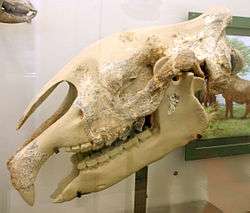Indricotheriinae
The subfamily Indricotheriinae are a group of long-limbed, hornless rhinoceroses commonly known as the paraceratheres that evolved in the Eocene epoch and lived until the early Miocene. The first paraceratheres were only about the size of large dogs, growing progressively larger in the late Eocene and Oligocene.[3] They were most common in the rainforest floodplain region which is now Kazakhstan, India, and southwest China, and lived further inland throughout northern and central Asia as well.
| Indricotheres | |
|---|---|
 | |
| Reconstructed Paraceratherium skull. | |
| Scientific classification | |
| Kingdom: | Animalia |
| Phylum: | Chordata |
| Class: | Mammalia |
| Order: | Perissodactyla |
| Family: | †Hyracodontidae |
| Subfamily: | †Indricotheriinae Borissiak, 1923 |
| Genera | |
| Synonyms[1] | |
The paraceratheres reached the peak of their evolution from the middle Oligocene to the early Miocene, where they became very large, herbivorous mammals. Most genera were about the size of modern draft horses and the extinct giant horse Equus giganteus, with some growing significantly larger. The largest genus was Paraceratherium, which was more than twice as heavy as a bull African elephant, and was one of the largest land mammals that ever lived. However, they remained confined to Asia, which at the time was mostly lush lowland floodplains. No fossil remains of paraceratheres have been found in Europe or North America, even though the paraceratheres had millions of years of opportunities to reach those regions. The collision with the Indian subcontinent and the Himalayan uplift led to global cooling, desertification, and the disappearance of forest habitats, which resulted in the extinction of these giant ungulates.
Although considered a subfamily of the Hyracodontidae by some authors, recent authors treat the paraceratheres as a distinct family, Paraceratheriidae (Wang et al. 2016 recover hyracodonts as more basal than paraceratheres).[4][5]
References
- Lucas, S.G.; Sobus, J.C. (1989). "The Systematics of Indricotheres". In Prothero, D. R.; Schoch, R. M. (eds.). The Evolution of Perissodactyls. New York, New York & Oxford, England: Oxford University Press. pp. 358–378. ISBN 978-0-19-506039-3. OCLC 19268080.
- Wood, H.E. (1963). "A Primitive Rhinoceros from the Late Eocene of Mongolia". American Museum Novitates (2146): 1–12.
- Palmer, D., ed. (1999). The Marshall Illustrated Encyclopedia of Dinosaurs and Prehistoric Animals. London: Marshall Editions. pp. 262–263. ISBN 1-84028-152-9.
- Z. Qiu and B. Wang. 2007. Paracerathere Fossils of China. Palaeontologia Sinica, New Series C 193(29):1-396
- H. Wang, B. Bai, J. Meng and Y. Wang. 2016. Earliest known unequivocal rhinocerotoid sheds new light on the origin of Giant Rhinos and phylogeny of early rhinocerotoids. Scientific Reports 6:39607:1-9.